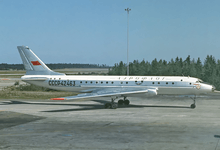Aeroflot Flight 3
Aeroflot Flight 03 (Russian: Рейс 3 Аэрофлота Reys 3 Aeroflota) was a passenger flight from Khabarovsk Airport to Petropavlovsk-Kamchatsky Airport. On 3 September 1962 the Aeroflot Tupolev Tu-104 lost control after the airframe started vibrating, resulting in the plane rolling and yawing several times at an altitude of 4,500 meters before crashing. The aircraft crashed into a swamp, some 90 kilometers away from Khabarovsk. At the time, it was the deadliest crash in the history of Soviet aviation.[1][2]
 An Aeroflot Tupolev Tu-104A, similar to the one involved in the accident | |
| Accident | |
|---|---|
| Date | 3 September 1962 |
| Summary | Loss of control |
| Site | near Kuruna, Nanaysky District |
| Aircraft | |
| Aircraft type | Tupolev Tu-104A |
| Operator | Aeroflot |
| Registration | СССР-42366 |
| Flight origin | Vnukovo Airport |
| Stopover | Khabarovsk Novy Airport |
| Destination | Petropavlovsk-Kamchatsky Airport |
| Occupants | 86 |
| Passengers | 79 |
| Crew | 7 |
| Fatalities | 86 |
| Survivors | 0 |
Aircraft
The aircraft involved in the accident was a Tupolev Tu-104A with two Mikulin AM-3M engines registered to Aeroflot as CCCP-42366. The aircraft was produced by the Omsk factory and was released to the Khabarovsk Far East Civil Aviation Directorate division of Aeroflot on 27 September 1958. The cabin of the aircraft had 70 seats; despite this 79 passengers were allowed on board. At the time of the accident the aircraft had 4,426 flight hours and sustained 1,760 pressurization cycles.[3]
Passengers and crew
On board the aircraft were 79 passengers, of which 58 were adults and 21 were children. Seven crew members were also aboard the flight. The cockpit crew consisted of the following:[3]
- Captain Petr Vasilievich Marsakov, serving as pilot in command
- Co-Pilot Viktor Mikhailovich Gritsenko
- Navigator Vasily Petrovich Zalavsky
- Flight Engineer Yuri Ivanovich Gusynin
- Radio operator Oleg Stepanovich Morozov
Description of accident
The air traffic controller instructed to follow the established corridor Troitskoe. Mild stratocumulus clouds were present along the designated route. At an altitude of 4,000 meters the aircraft ceased communications with Khabarovsk air traffic control, proceeding along the designated route. At 21:39 local time the pilot switched air traffic controllers, and after receiving permission started increasing altitude to 8,000 meters. The aircraft started experiencing control difficulties at 4,500 meters, approximately 1 minute and 37 seconds after the last communications with air traffic control. The pilots expressed dismay at the sharp roll of the wings; the aircraft disappeared from radar 36 seconds later, crashing into a swamp. All passengers and crew were killed in the crash.[1]
Cause
No official cause of the accident was discovered, but it was determined that the autopilot feature could have improved some aspects of control.
The commission responsible for investigating the accident concluded that:
"An emergency situation could be created by unintentional activation of the electric control with the elevator trimmer, as well as the trimmer aileron, although the latter is less dangerous than the inclusion of the elevator trimmer. As for the inadvertent loss of the rudder, the aircraft will still flyable, although it will significantly complicate the piloting of the aircraft. If the elevator is turned off after turning on the autopilot, and the balance of the aircraft is maintained by the trim tabs, then an emergency situation may occur if the autopilot is turned off."
It is worth noting that the civil commission was not allowed to review materials falling under the classification "Military Secret". This has led to so theories that the aircraft could have been accidentally shot down by a surface-to-air missile launched from the Litovko military base.[4]
References
- "Катастрофа Ту-104А Дальневосточного управления ГВФ близ Хабаровска". www.airdisaster.ru. Retrieved 2017-03-24.
- Ranter, Harro. "ASN Aircraft accident Tupolev 104A CCCP-42366 Khabarovsk". aviation-safety.net. Retrieved 2017-03-24.
- "Туполев Ту-104А Бортовой №: СССР-42366". russianplanes.net. Retrieved 2017-03-24.
- "РАКЕТЫ АТАКУЮТ ГРАЖДАНСКИЕ САМОЛЁТЫ - Еженедельная Газета "Новый Петербургъ" - "Новый Петербург" - Новости Санкт-Петербурга и России" (in Russian). 2014-01-23. Archived from the original on 2017-03-25. Retrieved 2017-03-24.